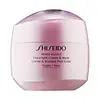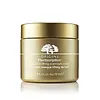What's inside
What's inside
 Key Ingredients
Key Ingredients

 Benefits
Benefits

 Concerns
Concerns

 Ingredients Side-by-side
Ingredients Side-by-side

Water
Skin ConditioningDimethicone
EmollientDipropylene Glycol
HumectantGlycerin
HumectantSd Alcohol 40-B
AstringentHydrogenated Polydecene
EmollientPEG-10 Dimethicone
Skin ConditioningSorbitol
HumectantPEG-150
HumectantPEG-400
Emulsion StabilisingDiisostearyl Malate
EmollientPEG-9 Polydimethylsiloxyethyl Dimethicone
EmulsifyingDisteardimonium Hectorite
StabilisingPEG-20
HumectantTrehalose
HumectantPotassium Methoxysalicylate
BleachingPhenoxyethanol
PreservativePolyvinyl Alcohol
Hydroxyethylcellulose
Emulsion StabilisingButylene Glycol
HumectantTrisodium EDTA
Hdi/Trimethylol Hexyllactone Crosspolymer
Sodium Citrate
BufferingDipotassium Glycyrrhizate
HumectantAlcohol
AntimicrobialParfum
MaskingCaffeine
Skin ConditioningCitric Acid
BufferingSodium Metaphosphate
BufferingPEG/PPG-14/7 Dimethyl Ether
Skin ConditioningPPG-3 Dipivalate
Skin ConditioningLinalool
PerfumingTocopherol
AntioxidantCitronellol
PerfumingSodium Metabisulfite
AntioxidantGeraniol
PerfumingPaeonia Albiflora Root Extract
Skin ConditioningSilica
AbrasiveCI 77491
Cosmetic ColorantAngelica Keiskei Leaf/Stem Extract
Skin ConditioningLimonene
PerfumingCrataegus Monogyna Flower Extract
Skin ConditioningRehmannia Chinensis Root Extract
Skin ConditioningPrunus Yedoensis Leaf Extract
Skin ConditioningZiziphus Jujuba Fruit Extract
Skin ConditioningPyrola Incarnata Extract
Skin ConditioningPotentilla Erecta Root Extract
Skin ConditioningAchillea Millefolium Extract
CleansingBenzoic Acid
MaskingWater, Dimethicone, Dipropylene Glycol, Glycerin, Sd Alcohol 40-B, Hydrogenated Polydecene, PEG-10 Dimethicone, Sorbitol, PEG-150, PEG-400, Diisostearyl Malate, PEG-9 Polydimethylsiloxyethyl Dimethicone, Disteardimonium Hectorite, PEG-20, Trehalose, Potassium Methoxysalicylate, Phenoxyethanol, Polyvinyl Alcohol, Hydroxyethylcellulose, Butylene Glycol, Trisodium EDTA, Hdi/Trimethylol Hexyllactone Crosspolymer, Sodium Citrate, Dipotassium Glycyrrhizate, Alcohol, Parfum, Caffeine, Citric Acid, Sodium Metaphosphate, PEG/PPG-14/7 Dimethyl Ether, PPG-3 Dipivalate, Linalool, Tocopherol, Citronellol, Sodium Metabisulfite, Geraniol, Paeonia Albiflora Root Extract, Silica, CI 77491, Angelica Keiskei Leaf/Stem Extract, Limonene, Crataegus Monogyna Flower Extract, Rehmannia Chinensis Root Extract, Prunus Yedoensis Leaf Extract, Ziziphus Jujuba Fruit Extract, Pyrola Incarnata Extract, Potentilla Erecta Root Extract, Achillea Millefolium Extract, Benzoic Acid
Water
Skin ConditioningDimethicone
EmollientIsododecane
EmollientGlycerin
HumectantBis-PEG-18 Methyl Ether Dimethyl Silane
EmollientPEG-10 Dimethicone
Skin ConditioningButylene Glycol
HumectantPentylene Glycol
Skin ConditioningDisteardimonium Hectorite
StabilisingRosa Damascena Flower Oil
MaskingLavandula Angustifolia Oil
MaskingPelargonium Graveolens Flower Oil
MaskingIllicium Verum Fruit/Seed Oil
MaskingCitrus Aurantium Bergamia Fruit Oil
MaskingCarthamus Tinctorius Seed Oil
MaskingMyristica Fragrans Kernel Oil
MaskingCitrus Aurantium Dulcis Peel Oil
MaskingCitrus Nobilis Peel Oil
MaskingCitrus Limon Peel Oil
MaskingLitsea Cubeba Fruit Oil
MaskingHibiscus Abelmoschus Extract
MaskingGeraniol
PerfumingLinalool
PerfumingCitronellol
PerfumingLimonene
PerfumingCitral
PerfumingCommiphora Mukul Resin Extract
Skin ConditioningPeucedanum Graveolens Extract
TonicBambusa Vulgaris Extract
Skin ConditioningSucrose
HumectantRubus Idaeus Leaf Extract
Skin ConditioningHelianthus Annuus Seed Extract
Skin ConditioningTriticum Vulgare Germ Extract
Skin ConditioningPrunus Amygdalus Dulcis Seed Extract
Skin ConditioningPisum Sativum Extract
Skin ConditioningAlgae Extract
EmollientHordeum Vulgare Extract
EmollientAnogeissus Leiocarpus Bark Extract
Skin ProtectingPorphyridium Cruentum Extract
Skin ConditioningSigesbeckia Orientalis Extract
Skin ConditioningCaffeine
Skin ConditioningAcetyl Hexapeptide-8
HumectantSorbitol
HumectantLaminaria Digitata Extract
Skin ProtectingSodium Hyaluronate
HumectantPullulan
Tocopheryl Acetate
AntioxidantGlucosamine Hcl
Squalane
EmollientCaprylic/Capric Triglyceride
MaskingHydroxypropyl Methylcellulose
Emulsion StabilisingPolysilicone-11
Propylene Carbonate
SolventPolyethylene
AbrasivePEG-6
HumectantPEG-32
HumectantCitric Acid
BufferingSodium Citrate
BufferingSodium Dehydroacetate
PreservativeDisodium EDTA
BHT
AntioxidantPhenoxyethanol
PreservativeWater, Dimethicone, Isododecane, Glycerin, Bis-PEG-18 Methyl Ether Dimethyl Silane, PEG-10 Dimethicone, Butylene Glycol, Pentylene Glycol, Disteardimonium Hectorite, Rosa Damascena Flower Oil, Lavandula Angustifolia Oil, Pelargonium Graveolens Flower Oil, Illicium Verum Fruit/Seed Oil, Citrus Aurantium Bergamia Fruit Oil, Carthamus Tinctorius Seed Oil, Myristica Fragrans Kernel Oil, Citrus Aurantium Dulcis Peel Oil, Citrus Nobilis Peel Oil, Citrus Limon Peel Oil, Litsea Cubeba Fruit Oil, Hibiscus Abelmoschus Extract, Geraniol, Linalool, Citronellol, Limonene, Citral, Commiphora Mukul Resin Extract, Peucedanum Graveolens Extract, Bambusa Vulgaris Extract, Sucrose, Rubus Idaeus Leaf Extract, Helianthus Annuus Seed Extract, Triticum Vulgare Germ Extract, Prunus Amygdalus Dulcis Seed Extract, Pisum Sativum Extract, Algae Extract, Hordeum Vulgare Extract, Anogeissus Leiocarpus Bark Extract, Porphyridium Cruentum Extract, Sigesbeckia Orientalis Extract, Caffeine, Acetyl Hexapeptide-8, Sorbitol, Laminaria Digitata Extract, Sodium Hyaluronate, Pullulan, Tocopheryl Acetate, Glucosamine Hcl, Squalane, Caprylic/Capric Triglyceride, Hydroxypropyl Methylcellulose, Polysilicone-11, Propylene Carbonate, Polyethylene, PEG-6, PEG-32, Citric Acid, Sodium Citrate, Sodium Dehydroacetate, Disodium EDTA, BHT, Phenoxyethanol
Ingredients Explained
These ingredients are found in both products.
Ingredients higher up in an ingredient list are typically present in a larger amount.
Butylene Glycol (or BG) is used within cosmetic products for a few different reasons:
Overall, Butylene Glycol is a safe and well-rounded ingredient that works well with other ingredients.
Though this ingredient works well with most skin types, some people with sensitive skin may experience a reaction such as allergic rashes, closed comedones, or itchiness.
Learn more about Butylene GlycolCaffeine is most associated with coffee, tea, and cacao. In skincare, it helps with calming inflammation and is rich in antioxidants.
While caffeine is used to treat cellulite and and dark circles, further studies are needed to prove this. It has been believed to help with these skin conditions due to its ability to dilate blood vessels and increase blood flow.
Some studies are looking into caffeine's ability to protect against UV rays.
Learn more about CaffeineCitric Acid is an alpha hydroxy acid (AHA) naturally found in citrus fruits like oranges, lemons, and limes.
Like other AHAs, citric acid can exfoliate skin by breaking down the bonds that hold dead skin cells together. This helps reveal smoother and brighter skin underneath.
However, this exfoliating effect only happens at high concentrations (20%) which can be hard to find in cosmetic products.
Due to this, citric acid is usually included in small amounts as a pH adjuster. This helps keep products slightly more acidic and compatible with skin's natural pH.
In skincare formulas, citric acid can:
While it can provide some skin benefits, research shows lactic acid and glycolic acid are generally more effective and less irritating exfoliants.
Most citric acid used in skincare today is made by fermenting sugars (usually from molasses). This synthetic version is identical to the natural citrus form but easier to stabilize and use in formulations.
Read more about some other popular AHA's here:
Learn more about Citric AcidCitronellol is used to add fragrance/parfum to a product. It is often derived from plants such as roses. In fact, it can be found in many essential oils including geranium, lavender, neroli, and more. The scent of Citronellol is often described as "fresh, grassy, and citrus-like".
Since the Citronellol molecule is already unstable, Citronellol becomes irritating on the skin when exposed to air.
Citronellol is a modified terpene. Terpenes are unsaturated hydrocarbons found in plants. They make up the primary part of essential oils.
Citronellol is not able to be absorbed into deeper layers of the skin. It has low permeability,
Citronellol is also a natural insect repellent.
Learn more about CitronellolDimethicone is a type of synthetic silicone created from natural materials such as quartz.
What it does:
Dimethicone comes in different viscosities:
Depending on the viscosity, dimethicone has different properties.
Ingredients lists don't always show which type is used, so we recommend reaching out to the brand if you have questions about the viscosity.
This ingredient is unlikely to cause irritation because it does not get absorbed into skin. However, people with silicone allergies should be careful about using this ingredient.
Note: Dimethicone may contribute to pilling. This is because it is not oil or water soluble, so pilling may occur when layered with products. When mixed with heavy oils in a formula, the outcome is also quite greasy.
Learn more about DimethiconeDisteardimonium Hectorite comes from the clay mineral named hectorite. It is used to add thickness to a product.
It can also help stabilize a product by helping to disperse other ingredients.
Hectorite is a rare, white clay mineral.
Learn more about Disteardimonium HectoriteGeraniol is used to add fragrance/parfum to a product. It is the main component of citronellol. It is a monoterpenoid and an alcohol.
Monoterpenes are naturally found in many parts of different plants.
Geraniol can be found in many essential oils including Rose Oil and Citronella Oil. The scent of Geraniol is often described as "rose-like". Many foods also contain Geraniol for fruit flavoring.
Geraniol can irritate the skin when exposed to air. However, irritation depends on the ability of geraniol to penetrate into the skin. In general, geraniol is not able to penetrate skin easily.
Geraniol is colorless and has low water-solubility. However, it is soluble in common organic solvents.
Like citronellol, it is a natural insect repellent.
2,6-Octadien-1-ol, 3,7-dimethyl-, (2E)-
Learn more about GeraniolGlycerin is already naturally found in your skin. It helps moisturize and protect your skin.
A study from 2016 found glycerin to be more effective as a humectant than AHAs and hyaluronic acid.
As a humectant, it helps the skin stay hydrated by pulling moisture to your skin. The low molecular weight of glycerin allows it to pull moisture into the deeper layers of your skin.
Hydrated skin improves your skin barrier; Your skin barrier helps protect against irritants and bacteria.
Glycerin has also been found to have antimicrobial and antiviral properties. Due to these properties, glycerin is often used in wound and burn treatments.
In cosmetics, glycerin is usually derived from plants such as soybean or palm. However, it can also be sourced from animals, such as tallow or animal fat.
This ingredient is organic, colorless, odorless, and non-toxic.
Glycerin is the name for this ingredient in American English. British English uses Glycerol/Glycerine.
Learn more about GlycerinLimonene is a fragrance that adds scent and taste to a formulation.
It's found in the peel oil of citrus fruits and other plants such as lavender and eucalyptus. The scent of limonene is generally described as "sweet citrus".
Limonene acts as an antioxidant, meaning it helps neutralize free radicals.
When exposed to air, oxidized limonene may sensitize the skin. Because of this, limonene is often avoided by people with sensitive skin.
The term 'fragrance' is not regulated in many countries. In many cases, it is up to the brand to define this term. For instance, many brands choose to label themselves as "fragrance-free" because they are not using synthetic fragrances. However, their products may still contain ingredients such as essential oils that are considered a fragrance.
Learn more about LimoneneLinalool is a fragrance and helps add scent to products. It's derived from common plants such as cinnamon, mint, citrus, and lavender.
Like Limonene, this ingredient oxidizes when exposed to air. Oxidized linalool can cause allergies and skin sensitivity.
This ingredient has a scent that is floral, spicy tropical, and citrus-like.
Learn more about LinaloolPeg-10 Dimethicone is silicone with conditioner and emulsifier properties. It mostly acts as an emollient in skincare and and humectant in haircare.
According to the manufacturer, acidic formulations decrease the stability of this ingredient. It works best in neutral or near neutral formulations.
Phenoxyethanol is a preservative that has germicide, antimicrobial, and aromatic properties. Studies show that phenoxyethanol can prevent microbial growth. By itself, it has a scent that is similar to that of a rose.
It's often used in formulations along with Caprylyl Glycol to preserve the shelf life of products.
Sodium Citrate is the sodium salts of citric acid. In skincare, it is used to alter pH levels and acts as a preservative.
Its main functions are to maintain the pH of a product and neutralize metal ions.
The acidity of our skin is maintained by our glands and skin biome; normal pH level of skin is slightly acidic (~4.75-5.5).
Being slightly acidic allows our skin to create an "acid mantle". This acid mantle is a thin barrier that protects our skin from bacteria and contaminants.
Learn more about Sodium CitrateSorbitol is a sugar alcohol. It is a hydrating and moisturizing agent created from the reduction process of glucose.
Most sorbitol is usually made from potato starch. It is also found in fruits such as apples and pears.
As a humectant, Sorbitol helps draw water to the skin. This helps keep the skin hydrated. Sorbitol also helps create a thicker texture in products. You might find sorbitol in your toothpaste and other gels.
It is a non-irritating ingredient that is great for those with dry skin.
Sorbitol is a prebiotic. It helps promote the growth of healthy bacteria on your skin. The bacteria on your skin form a microbiome. This microbiome helps protect your skin from infection and harmful bacteria.
Learn more about SorbitolWater. It's the most common cosmetic ingredient of all. You'll usually see it at the top of ingredient lists, meaning that it makes up the largest part of the product.
So why is it so popular? Water most often acts as a solvent - this means that it helps dissolve other ingredients into the formulation.
You'll also recognize water as that liquid we all need to stay alive. If you see this, drink a glass of water. Stay hydrated!
Learn more about Water